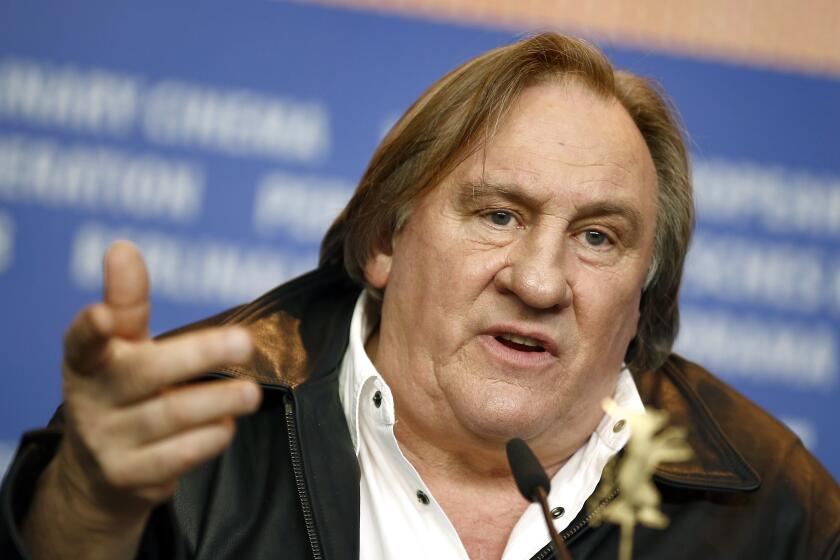A touch of the little town blues
WELL, it’s that time again. I have only a few more days to fill out my academy ballot. Now I have to spring into high gear to see the movies I’ve missed. The good part is that most of the big movie houses in New York are in walking distance from my West Side apartment. The bad part is that this is the season I begin missing my old life as an academy member in Hollywood.
I remember every February driving in from Malibu and running from one Westwood movie house to another, shouting and waving to dozens of other academy members, everyone in a furious rush to see films -- sometimes two or three a day -- before the voting deadline.
A Los Angeles screenwriter for 30 years, I moved to New York in the 1990s to write plays. During my first winter here I walked up to the window of a movie house on Broadway, handed over my academy card and said: “Two for the 8:30 show.”
The girl stared at the card and said: “What’s this?” “Academy card,” I said, and showed her the newspaper advertisement with the little block of letters at the bottom -- “Your AMPAS membership card will admit you and a guest to any performance.”
“What’s AMPAS?” she said.
“Well,” I said, forgetting momentarily what the letters actually stand for, “it’s the film academy. You know, we vote on the Oscars.”
“Just a second,” she said, slipping off her chair and disappearing and then returning with the manager. “This gentleman says he belongs to something here.”
After a lot of staring and comparing and ID producing, they finally let me in. But the experience was an eye-opener. In Hollywood, this little card is gold. In New York, it represents just one more grubby hand demanding a freebie.
Don’t get me wrong. New York has a lot of interest in films. They make them here, and there are plenty of first-rate actors, even stars (De Niro, Paltrow, Pacino), who live here. But it’s just not the same. New York is a theater town, a book town, an art town, a magazine town, an opera town, a ballet town. When someone talks about “the industry” in Los Angeles, everybody knows there is only one.
The Samuel Goldwyn Theater in the huge academy building on Wilshire Boulevard seats more than a thousand. It’s surrounded by beautiful exhibition space, a splendid library, conference rooms and offices staffed by dozens, maybe hundreds.
When I arrived in New York, the academy showed films in a small theater in the sub-basement of the Museum of Modern Art. After the museum renovation began in 2002, we became gypsies, wandering from one screening room to another. Now we have a permanent home on 59th Street at the Lighthouse International, an organization for the blind (no jokes, please, it’s a very nice place). We watch films in a 240-seat auditorium with a state-of-the-art screen, new projectors and surround sound.
The academy office in New York opened in 1999 with one staff member. It still has one staff member. Patrick Harrison, smiling and personable, sits behind his desk in a small room on the seventh floor of Lighthouse International surrounded by classic movie posters. “Whatever they do in Hollywood we do here,” he says. “Why should they have all the fun? Except they have a department for each activity and I do it all.”
Patrick runs all of the New York events: a full schedule of screenings year-round. Plus the academy screenings of documentaries, foreign films, short subjects and animation. Plus the night we choose the Eastern finalists for the Student Academy Awards. Plus “Monday Nights With Oscar,” public showings of classic films with special guests.
A few months ago, Lee Grant, my old Malibu neighbor, spoke to a packed house at the showing of “Shampoo.” We hugged and kissed, talked about our kids, promised each other we’d get together soon. Haven’t done it yet -- I’m writing plays, she’s directing documentaries. But it was fun to see a familiar face from the old days.
There are 6,000 academy members and about 600 live in New York. About 50 to 75 come to the weekly screenings. Sylvia Miles is a regular. Arlene Dahl comes. Also Susan Kohner. Robert Wuhl, sometimes. Jane Powell turns up occasionally. I’m there, along with some other “mature” writers, PR people, animators, documentarians, character actors. Same as in Hollywood, just smaller.
*
A personal touch
PATRICK runs the academy like a mom-and-pop store. Everyone gets a personal greeting as they arrive for screenings. I came late one night for the new Woody Allen film (walked through the park instead of taking the bus). The lobby was empty. Patrick appeared, took my hand and whispered: “It’s the first scene, Jonathan Rhys-Meyers is applying for a job as a tennis pro, you missed 30 seconds.” And with that he opened the doors to the darkened theater and led me to my seat.
Patrick says: “There is not an East Coast branch or a West Coast branch. We’re all part of the same academy. We do the same things they do in L.A.”
But with perhaps not quite the same buzz. I remember the full houses watching new releases at the Samuel Goldwyn Theater. A second showing if it was a hot film. I remember the first screening of “Star Wars.” The laughter at the titles, the whoops of delight and wild applause at the entrance of the first spaceship, the waves of excitement that swept through the theater as the special effects hit the screen. You had to be there, to hear it, to feel it, to know that something extraordinary was happening. And I remember the day Kate Hepburn and Cary Grant walked in like royalty.
I’ve been an academy member since 1970, but I’ve been to the Oscars only once. In 1998 I put on my tuxedo, drove down the freeway, schlepped down the short red carpet at the Shrine Auditorium while the stars were making their stately entrances on the long red carpet. I felt like an extra dressed up for somebody else’s party.
In New York we also have a party on Oscar night, usually at a first-class restaurant, Tavern on the Green or Le Cirque. One hundred and fifty people: black tie, cocktails at 6:15, then settle down at 8 to eat and watch the Oscar show on big screens. It’s an elegant viewing party. No awards. Some years the mayor comes.
In 1993 there was actually a live satellite hookup from our dinner at the Russian Tea Room during which Dustin Hoffman and Anne Bancroft, celebrating the 25th anniversary of “The Graduate,” presented the screenwriting Oscars. Never happened again.
We don’t get a lot of media coverage. No star power -- the mega-stars who live in the East having all flown to Los Angeles for the big night. Actually our evening sounds a little like what the original Academy Awards were all about -- the family getting together at the Roosevelt or the Ambassador for dinner and drunken repartee, with some awards added on for fun. This year we’ll be at the St. Regis, with chocolate Oscars for each table flown in by Wolfgang Puck. Arthur Manson (PR branch) and Arlene Dahl will co-host. Patrick says it’s the Governors Ball of the East.
Maybe I’ll get out my tuxedo and go. Or maybe I’ll host my own regular New York Oscar party -- popcorn, beer and turkey sandwiches in front of the TV. The New York friends who crowd into my tiny living room are mostly theater people, aspiring playwrights and actors, some book writers, a stand-up comedian, an accountant who makes documentaries. They don’t know much about Hollywood.
If I can find my Fay Wray B’nai B’rith Statuette that I found at a garage sale, I put it on top of the TV to get us in the right mood. Everybody puts a dollar in a hat and we mark votes on our homemade ballots and then watch the show. I keep score.
I’m the only academy member present. I always win.
*
Mayo Simon is a playwright and screenwriter whose movie credits include “Marooned,” “Futureworld” and “I Could Go On Singing.” He has also taught screenwriting at Columbia University and UCLA.
More to Read
Only good movies
Get the Indie Focus newsletter, Mark Olsen's weekly guide to the world of cinema.
You may occasionally receive promotional content from the Los Angeles Times.






